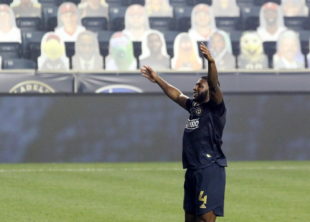Photo: Paul Rudderow
Major League Soccer’s Best XI for 2020 included two Philadelphia Union Homegrown Players, attacking midfielder Brenden Aaronson and center back Mark McKenzie.
Many people have written much and made more about the honor done to each player, and the honor done to their club. There has been talk about the Union Way, imitating it, and speculating about it as the league’s way forward into the future.
But no one is pointing out that they are praising a system whose final developmental step no longer exists.
As of this past October, the path that produced Aaronson and McKenzie and the other first-teamers past and present who are honored by association does show that pressure has produced diamonds. The Union’s duo are certainly such gems. But the pressure source that created them will no longer be used, at least by the Union, Portland, and to a lesser degree Orlando City.
Those three clubs have cut ties with the United Soccer League. What is now called the United Soccer League Championship provided the stepping stone for Aaronson and McKenzie between the Union’s Academy and the Union itself. That stone in their day was fully professional and was called Bethlehem Steel FC. It is now Philadelphia Union II. Aaronson eschewed college and stepped to his stone straight away. McKenzie did a fall semester at Wake Forest before becoming one of Ernst Tanner’s preferred Homegrown alternatives to all his Super Draft picks back in January of 2019.
Aaronson and McKenzie no longer exemplify what the Union Way will be. They only show what the Union Way has been.
The Union Way moving forward will of necessity be different. Why it abandoned USL we can only speculate. Almost certainly its competitive pressure was adequate to develop players. Perhaps it had to do with issues of control and expense.
Nor do we know how different the new stepping stone will be, since we in the general public have no idea what is coming. We cannot not even know what is hoped for since presumably it is still in negotiation. We only know that there are supposed to be forthcoming announcements. That announcement assurance was given two months ago, and we are now 40% closer to March 1 when North American professional seasons would normally take shape for 2021.
2020 saw two major transitions in elite youth player development in the United States. The first, the replacement of the U. S. Soccer Development Academy (DA) by MLS NEXT, is quantitatively more numerous and chronologically more immediate than what will replace the USLC stepping stone.
That MLS NEXT has drawn primary attention makes sense. It affects MLS, USL, and dozens of independent youth academies that operate on academia’s calendar year, and that is without reference to females. These thousands of players had to have their competitive platform prepared in time for late summer and early fall, whether or not preparation was further complicated by the COVID-19 pandemic.
What comes after the academy level is being addressed after the academy level. The elite youth player development stepping stone transition is amorphous. There are only two certainties.
- MLS NEXT allows participating clubs to omit amateur U19 sides. Some MLS academies have done so for 2020-21, but others have not.
- And three MLS organizations have abandoned USL Championship or USL League One as their stepping stone, others have affirmed them, and still others are withholding their decisions until they see what emerges.
For those outside the decision-making process beyond those two points nothing is clear. Ownership and upper management probably have solid working assumptions, but that itself is an assumption unsupported by comment.
Our next solid clues about the new stepping stone to the first-team may come if the organization announces roster developments concerning 2020 Union II players.
In past years those USL contracts were widely represented as expiring on November 30. On December 6, 11 of the 12 2020 players remain listed on the organization’s Union II roster. Only Saed Diaz has been removed. Only five of the remaining eleven received Twitter mentions as participating or present during the Union II’s five post-season “friendlies.”
The honors to Mark McKenzie and Brenden Aaronson validate an historical process in the past that did an excellent job creating MLS players while it existed. But they do not forecast a process that leads into the future, because that future is being changed even as all of us are writing or reading these words.


I’m very curious to see where MLS is going with all of this – and why we couldn’t achieve our goals within one of the levels of USL.